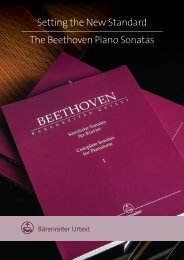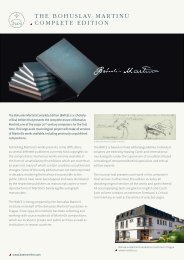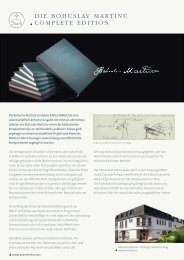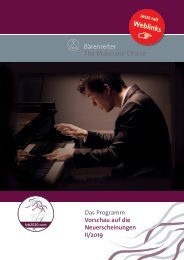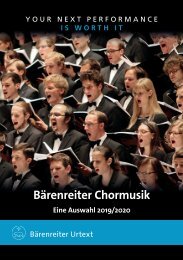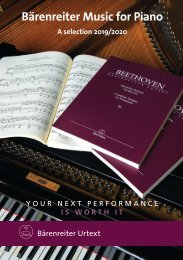SPA234_Strings_2018_2019_web_mit_Links
Create successful ePaper yourself
Turn your PDF publications into a flip-book with our unique Google optimized e-Paper software.
Dvořák, Antonín<br />
(1841–1904)<br />
Mazurek op. 49<br />
for violin and piano<br />
Eds. J. Hanuš, K. Šolc<br />
H 1550 Score with part<br />
Romance in F min op. 11<br />
for violin and piano<br />
Urtext / Ed. J. Hájek<br />
BA 9571 Score with part<br />
Originally written for violin<br />
and orchestra between 1873<br />
and 1877, Dvořák’s Romance<br />
immediately followed his<br />
String Quartet in F minor (1873)<br />
and draws on the theme of its<br />
slow movement.<br />
Our edition is the first to avail<br />
itself of the recently<br />
rediscovered autograph of<br />
Dvořák’s own version for violin<br />
and piano. Compared to the<br />
well-known piano reduction<br />
by J. Zubatý, it differs from the<br />
orchestral version in several<br />
important respects and is also<br />
one bar shorter. Our new<br />
edition, containing the<br />
composer’s more authentic<br />
version, can nevertheless also<br />
serve as a piano reduction to<br />
the orchestral version.<br />
“A pristine, unencumbered<br />
violin part is enhanced by an<br />
equally spacious piano score.”<br />
(<strong>Strings</strong>)<br />
Romantic Pieces op. 75<br />
for violin and piano<br />
Eds. A. Pokorný, K. Šolc<br />
BA 9576 Score with part<br />
Composed in 1887, the Romantic<br />
Pieces op. 75 were originally<br />
intended for two violins and<br />
viola. Immediately after<br />
completing these four short<br />
pieces, Dvořák rewrote them<br />
for violin with piano<br />
accompaniment.<br />
This edition presents the<br />
musical text from the<br />
Complete Edition of the Works<br />
of Antonín Dvořák with a new<br />
foreword by David R. Beveridge.<br />
The violin part contains<br />
fingering by Josef Micka.<br />
Dvořák, Antonín<br />
(1841–1904)<br />
Sonatina in G maj op. 100<br />
for violin and piano<br />
Ed. A. Čubr<br />
Violin part revised by J. Feld<br />
H 1364 Score with part<br />
Franck, César<br />
(1822–1890)<br />
Sonata, Andantino quietoso<br />
op. 6, Mélancolie<br />
for piano and violin<br />
Urtext / Ed. D. Woodfull-Harris<br />
With an introduction by<br />
G. Schütz<br />
BA 9425 Score with part<br />
Cesar Franck’s Sonata for Piano<br />
and Violin is a masterpiece of<br />
cyclic form with a gracefulness<br />
and expressive force almost<br />
paradigmatic for the age of<br />
musical Romanticism. This<br />
work was composed in 1886<br />
and was dedicated to the<br />
Belgian violinist and composer<br />
Eugène Ysaÿe.<br />
Franck’s correspondence<br />
proves that he was directly<br />
involved in the printing of the<br />
sonata. Consequently, our<br />
scholarly performing edition<br />
draws mainly on the first<br />
edition of the separate violin<br />
part. For the piano part, the<br />
first edition of the version for<br />
violoncello and piano, which<br />
appeared during Franck’s<br />
lifetime, was an important<br />
Fiocco, Joseph-Hector<br />
(1703–1741)<br />
Violin<br />
Allegro for violin and piano<br />
Bärenreiter's Concert Pieces<br />
BA 8977<br />
page 83<br />
source as many engraver’s<br />
errors found in the first<br />
printing of the violin version<br />
had been corrected in this<br />
violoncello version. In addition<br />
to these sources, both<br />
autograph scores of the violin<br />
sonata (Franck’s working copy<br />
and his fair copy) were<br />
consulted to clarify<br />
questionable readings.<br />
Bärenreiter’s edition also<br />
includes two short separate<br />
movements for the same<br />
instrumentation: the early<br />
Andantino quietoso op. 6 (1843),<br />
a hauntingly beautiful piece<br />
composed for performances<br />
with Franck’s violinist brother<br />
Joseph, as well as Mélancolie,<br />
first published after Franck’s<br />
death in 1911. This second piece<br />
is based on a solfège exercise<br />
and written at the height of the<br />
composer’s creative powers,<br />
at about the same time as his<br />
famous violin sonata.<br />
The edition is rounded off by<br />
an informative text on the<br />
genesis and reception history<br />
of the three compositions<br />
(Ger/Fr/Eng), a complete list of<br />
sources, editorial notes and a<br />
Critical Commentary (Eng).<br />
Pioneering new Urtext<br />
edition<br />
Informative text on the<br />
genesis and reception<br />
history of the sonata and<br />
its versions (Ger/Fr/Eng)<br />
Two small individual<br />
movements for violin and<br />
piano published for the<br />
first time<br />
15









